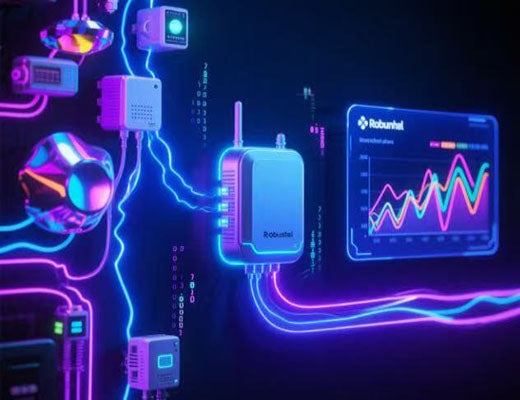
Creating Real-Time Dashboards for Your IoT Data with InfluxDB and Grafana
|
|
Time to read 5 min
|
|
Time to read 5 min
You've successfully connected your sensors and are collecting data on your industrial IoT edge gateway. Now what? Raw data sitting in a database is useless until you can see it.
This guide focuses on that final, crucial step: data visualization. We'll provide a practical walkthrough of how to use Grafana to create a compelling, real-time Grafana IoT Dashboard from the sensor data stored in InfluxDB on a Robustel gateway.
This article is designed for data analysts, operations managers, and anyone who needs to transform raw IIoT data into actionable insights.
I've seen it happen in countless projects: a team spends months engineering a brilliant data collection system, only to have the valuable data sit unused in a database, invisible to the people who need it most. Let's be clear: if you can't see your data, you can't act on it. This is where data visualization becomes the most critical part of your IoT solution.
The good news is, you don't need an expensive, complex cloud platform to create professional-grade dashboards. By running the open-source visualization tool Grafana directly on your Industrial IoT Edge Gateway , you can create a powerful, real-time monitoring solution right at the edge. In this guide, we'll show you exactly how to build your first Grafana IoT Dashboard, turning a stream of raw sensor numbers into a clear, actionable view of your operations.

To build our dashboard, we need two key pieces of the "MING" software stack.
● InfluxDB : The Time-Series Database: Think of InfluxDB as the perfect memory for your sensor data. Unlike a general-purpose database, it's purpose-built to handle massive volumes of timestamped data points, making it incredibly efficient for storing and querying things like temperature, pressure, or vibration over time.
● Grafana: The Visualization Engine: Grafana is the window into your data. It's a powerful open-source platform that connects to data sources like InfluxDB and allows you to build beautiful, interactive dashboards with graphs, gauges, tables, and alerts. You can learn more at the official Grafana: The open and composable observability platform | Grafana Labs .
On a Robustel gateway like the EG5120 , accessing Grafana is simple:

The fastest way to get started is by importing a pre-made dashboard template. The Robustel IIoT Starter Kit comes with a dashboard file specifically for the S6000U sensor.
That's it! Your dashboard will instantly come to life, populated with real-time data from your sensor.
One of Grafana's most powerful features is its extensive library of plugins, which allow you to add new types of visualizations. The real 'aha!' moment for many users is realizing they can find a panel for almost any data type imaginable.
For example, the pre-built S6000U dashboard uses a special plugin to visualize the tilt sensor. To install it:
Once installed, the new panel type will be available when you create or edit your Grafana IoT Dashboard.
A well-designed Grafana IoT Dashboard transforms streams of numbers into immediate insights. The pre-built dashboard for the S6000U visualizes all seven of its sensor readings:
You now have a clear, at-a-glance understanding of your operational environment, powered entirely by your edge gateway.

A1: No. Because Grafana and the InfluxDB database are running directly on your local EG5120 gateway, you can access the dashboard from any computer on the same local network, even if the gateway's internet connection is down.
A2: A time-series database, like InfluxDB, is specifically designed to efficiently store and retrieve data with a timestamp, like sensor readings. Grafana is a visualization tool that excels at creating graphs and dashboards from this type of data, making them a perfect pair for any IoT application.
A3: Absolutely. After importing the initial dashboard, you can easily add, remove, and configure panels. You can choose from dozens of built-in panel types (like graphs, gauges, tables, and bar charts) and connect each one to a specific data metric from your InfluxDB database.







